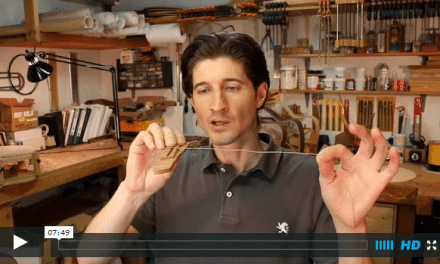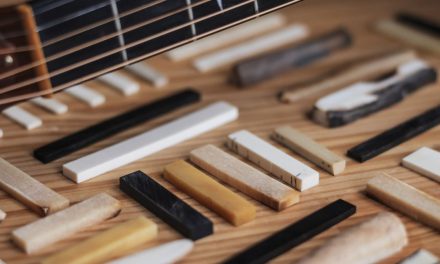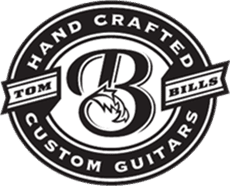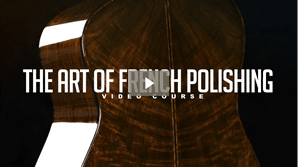
I’ve always believed that it’s vital to remember we are not starting from scratch.
We owe a great debt to the skilled craftspeople who were brave enough to strive for excellence in their work, and generous enough to share the hard-won wisdom they earned.
Their generosity gives us a huge advantage as we endeavor to deepen our understanding, improve our guitars, and find our own unique path.
One such resource that was, and still is, inspiring and helpful to me in this way is the book, “Making Master Guitars” by Roy Courtnall.
In this article, I’ll share an overview of the book and a few thoughts on why I consider it a “Must-Have” for any luthier.
I’ll also show you a step-by-step exercise I enjoy using to fill my “creative well,” maximize and enrich my learning, and excavate new ideas from this book year after year.
(I even made you a video playlist – see below)
Let’s start with a quick overview of what’s included in this book…
Making Master Guitars – Book Outline:
Making Master Guitars was published in 1993 by Luthier Roy Courtnall. It’s a beautifully bound book with over 330 pages of detailed guitar-making information, including clear and well-drawn illustrations, rare photos, and more.
Part 1: The Master Makers And Their Guitars
This section contains detailed sets of guitar body shapes, rosettes, bridges, headstocks, measurements, and more from some of the greatest guitars ever made; a treasure trove of inspiration and information.
Part 2: Workshop, Tools, And Materials
This section covers the essential tools and materials needed to build a guitar in the Spanish style. The minimal tooling and simple systems are great examples for anyone just getting started or who wants to work in a more traditional manner.
Part 3: Guitar Construction–The Spanish Method
This section contains a detailed step-by-step method for building a guitar. It includes clear and beautiful illustrations and photographs of the author building his guitars, plus, if you look closely, it contains photos showing Robert Bouchet and Daniel Friederich building their guitars as well.
Appendix
The additional appendix section includes even more helpful information, such as conversion tables, fret spacing tables, and a supplier list for materials, tools, and plans.
Always Start With The Tradition (Why I Love This Book)
I started building guitars here in St Louis, Missouri, in the 1990s, and it was extremely difficult to find luthiers to learn from.
The internet wasn’t much help back then either, so I was mainly limited to finding what I could in the bookstore – remember those ancient things? (Man, I miss them).
The first guitar I built was an archtop. Thankfully, I was able to build it with the help of Bob Benedetto‘s book Making An Archtop Guitar ( another must-have for that type of instrument).
I continued building archtops for a few years after that, but as my luthier career progressed, a client wanted me to build them a nylon string guitar.
This presented a problem. I had many years of experience playing, owning, and building steel string and archtop guitars, but I had never owned a nylon-string instrument.
During the design phase of that first nylon string guitar, I worked to get as many excellent guitars into my hands to study and play as I could, but taking measurements and tracings was difficult, risky, and awkward on instruments I didn’t own.
I had a basic idea of what I wanted to build, but I still didn’t feel confident in my design.
Something inside me knew that it lacked a solid foundation…
Until I found this book!
I don’t remember how, but I just happened to find “Making Master Guitars” while I was working on that first nylon string guitar design.
The detailed measurements of the master guitars it contained gave me a point of reference on which to base the first iteration of my nylon string design.
To this day, the content of this book serves as an anchor point for almost any new design I create, regardless of guitar type.
Always start with the tradition.
Filling The Well – How to Get Even More From This Book
Some time ago, I realized that many of the master’s guitars detailed in section 1 of this book can now be found online in videos.
Just for fun at first, I began a little exercise of studying the measurements and designs while listening to the guitars being played.
It’s similar to what Julia Cameron calls “Filling the well” in her book “The Artist’s Way.”
Over time, this has become one of my favorite ways to stimulate new ideas, search for new connections, and keep my “creative well” topped off.
Here are the steps I use:
- Make a coffee or tea
- Open the book to a guitar that you want to study (or us a blueprint that you already have)
- Find a video of that guitar being played and hit play.
- As I listen, I let my eyes rest on the images, text, and measurements, absorbing the info and listening within myself for the emergence of new thoughts, ideas, and connections.
I try not to overcomplicate it; I just let it happen and let my mind wander and saunter a bit to see where the path might lead me.
Sounds fun, right?
Ready to give it a try?
If so, I put together a little playlist featuring some of the guitars detailed in this book for you.
(You can find more videos, and maybe even better ones, but this is a starting place for you to begin exploring this type of multi-sense learning.)
So, make a fresh coffee, grab your favorite blueprint or a copy of Making Master Guitars, hit play, and see what happens.
(Headphones recommended)
Note: Sometimes, you’ll have new thoughts and ideas right away. Other times, new ideas will emerge later on while you’re on a walk or sitting at a stop light, so try to force anything; just have fun and fill that creative well.
Final Thoughts
To me, as a luthier, this book is a priceless treasure trove of information.
I could never get access to all the guitars detailed in the book, but thanks to Roy (the author), anyone can use the measurements and other information he gathered about them to reference and learn from as they work.
In addition, his sections on tools and the guitar-building process are full of insights and unique techniques to learn from and try in your own work.
If you’re building a guitar based on the work of the master luthiers featured within or simply using their work as a reference to keep your unique designs safely grounded in tradition–this book is a must-have!










not available anymore @ amazon.com “Temporarily out of stock.”
Hi Luis,
Until they get it in stock, on the Amazon page you click the links under the two main options and you can view other sellers for new and used versions of the book. The used versions are quite a bit less expensive: Used here is a link to the other sellers of the new version: New
Hope that helps!
– Tom
Glad you have found the book useful.
It is easy to find on ebay, abebooks, amazon, or direct from the publisher Robert Hale Ltd (now taken over by Crowood Press). The French edition is available from Editions Vial in France.
Cool, thanks Roy!
Ordered it last week, and it arrived today.
WOW!
All I can say is wow.
And this:
Dear reader:
If you’re starting out, and you have done your research, and you are reading this review, and hopefully my comment, hear this, please.
I’m a rookie, but my mentors in film production and writing trained me to do my research well.
Which means reading, learning and inwardly digesting.
A lot of it, basically starting with everything in print.
And I do mean, quite literally everything that’s on sale, and a lot more online and out-of-print.
So to date I own and have read books by:
Bogdanovich
Cumpiano
Doubtfire
Forbes
Kinkead
Overholzer
Rodriguez
Siminoff
Sloane
Somogyi
and Romanillos, just ordered hot off the press from Spain.
I even have a copy of the book that Romanillos allegedly learned from in the 50’s.
Now, if you consider that just the two books by Somogyi are more than a couple hundred bucks by themselves, you’ll see that I’ve put quite a bit of investment into my research, both in time and money, since I do want to be good at this, and in my book, solid theory is essential to lay the foundation for effective practice.
I’m not including Tom’s Art of Lutherie Book because it’s not really about the actual construction method like the others are.
So – DO TAKE MY ADVICE.
Bite the bullet and buy this book first.
Yes, as Tom has mentioned, it is expensive. But worth every penny.
Take it from one who’s just been there ahead of you.
Best
Chris